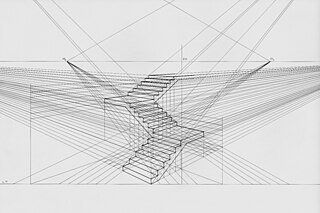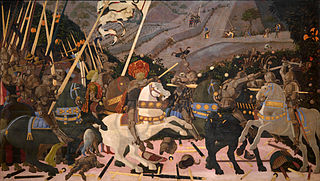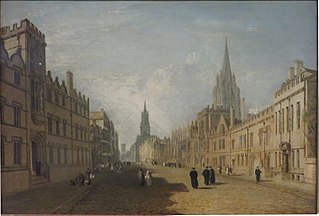
Paolo Uccello, born Paolo di Dono, was an Italian painter and mathematician who was notable for his pioneering work on visual perspective in art. In his book Lives of the Most Excellent Painters, Sculptors, and Architects, Giorgio Vasari wrote that Uccello was obsessed by his interest in perspective and would stay up all night in his study trying to grasp the exact vanishing point. Uccello used perspective to create a feeling of depth in his paintings. His best known works are the three paintings representing the battle of San Romano, which were wrongly entitled the Battle of Sant'Egidio of 1416 for a long period of time.

The Ashmolean Museum of Art and Archaeology on Beaumont Street, Oxford, England, is Britain's first public museum. Its first building was erected in 1678–1683 to house the cabinet of curiosities that Elias Ashmole gave to the University of Oxford in 1677. It is also the world's second university museum, after the establishment of the Kunstmuseum Basel in 1661 by the University of Basel.

Linear or point-projection perspective is one of two types of graphical projection perspective in the graphic arts; the other is parallel projection. Linear perspective is an approximate representation, generally on a flat surface, of an image as it is seen by the eye. Perspective drawing is useful for representing a three-dimensional scene in a two-dimensional medium, like paper.
Jon James Lamont Whiteley was a Scottish child film actor and in adult life a distinguished art historian.

BartolomeoMontagna was an Italian Renaissance painter who mainly worked in Vicenza. He also produced works in Venice, Verona, and Padua. He is most famous for his many Madonnas and his works are known for their soft figures and depiction of eccentric marble architecture. He is considered to be heavily influenced by Giovanni Bellini, in whose workshop he might have worked around 1470. Benedetto Montagna, a productive engraver, was his son and pupil and active until about 1540. He was mentioned in Vasari's Lives as a student of Andrea Mantegna but this is widely contested by art historians.

The School of Athens is a fresco by the Italian Renaissance artist Raphael. It was painted between 1509 and 1511 as part of a commission by Pope Julius II to decorate the rooms now called the Stanze di Raffaello in the Apostolic Palace in Vatican City. Garson Holzli

The Battle of San Romano is a set of three paintings by the Florentine painter Paolo Uccello depicting events that took place at the Battle of San Romano between Florentine and Sienese forces in 1432. They are significant as revealing the development of linear perspective in early Italian Renaissance painting, and are unusual as a major secular commission. The paintings are in egg tempera on wooden panels, each over 3 metres long. According to the National Gallery, the panels were commissioned by a member of the Bartolini Salimbeni family in Florence sometime between 1435 and 1460. The paintings were much admired in the 15th century; Lorenzo de' Medici so coveted them that he purchased one and had the remaining two forcibly removed to the Palazzo Medici. They are now divided between three collections, the National Gallery, London, the Galleria degli Uffizi, Florence, and the Musée du Louvre, Paris.

Saint George and the Dragon is a painting by Paolo Uccello dating from around 1470. It is on display in the National Gallery, London, United Kingdom. It was formerly housed in the Palais Lanckoroński in Vienna, belonging to Count Karol Lanckoroński and sold by his son and heir Anton in 1959 through Mr. Farago. The first mention of it being there is 1898.
William Thomas Horner Fox-Strangways, 4th Earl of Ilchester FRS, styled The Honourable William Fox-Strangways until 1858, was a British diplomat, Whig politician and art collector. He served as Under-Secretary of State for Foreign Affairs under Lord Melbourne from 1835 to 1840 and was Envoy Extraordinary and Minister Plenipotentiary to the German Confederation from 1840 to 1849.

Bicci di Lorenzo (1373–1452) was an Italian painter and sculptor, active in Florence.

The Funerary Monumentto SirJohn Hawkwood is a fresco by Paolo Uccello, commemorating English condottiero John Hawkwood, commissioned in 1436 for Florence Cathedral. The fresco is an important example of art commemorating a soldier-for-hire who fought in the Italian peninsula and is a seminal work in the development of perspective.
The Ideal City is the title given to three strikingly similar Italian Renaissance paintings of unresolved attribution. Being kept at three different places they are most commonly referred to by their location: The Ideal city of Urbino, Baltimore, and Berlin. Hubert Damisch, who has written at length about the paintings, refers to them as the "Urbino perspectives" or "panels". The three paintings are dated to the late 15th century and most probably they have different authors but various attributions have been advanced for each without any consensus. There is also a discussion about the purpose of the paintings as they are all in an unusual elongated format. In 2012 the Baltimore and Urbino panels were shown at a joint exhibition, with the Berlin painting being represented by a copy, as the original is too fragile to be shipped abroad.

The Impey Album was a collection of Company style paintings commissioned by Elijah Impey (1732–1809) and his wife Mary, née Reade (1749–1818), of the animals in their menagerie in Calcutta, India, where Elijah was chief justice of the Supreme Court.

High Street, Oxford is an oil painting by J. M. W. Turner that was exhibited in 1810.
Antonia di Paolo di Dono (1456–1491) was the daughter of Paolo di Dono, nicknamed Uccello, a well-known early Renaissance Florentine painter. Giorgio Vasari's biography of Uccello states that he had "a daughter who knew how to draw." Antonia was recorded in the Libro dei Morti of the painter's guild, Arte dei Medici e Speziali, as a "pittoressa." This was the first time the feminine form of the word "painter" appears in Florentine public records and the first formal recognition of a fifteenth-century woman artist.
Catherine Whistler is an Irish art historian and curator, specialising in Italian Renaissance and Baroque art. She is Keeper of Western Art at the Ashmolean Museum, a supernumerary fellow of St John's College, Oxford, and Professor of the History of European Art at the University of Oxford.

Annunciation is a gold and tempera on panel painting by Paolo Uccello executed c. 1425. It is now in the Ashmolean Museum in Oxford, England, to which it was given by William Thomas Herner Fox-Strangways in 1850.

View of Auvers-sur-Oise is the common English name for a Paul Cézanne painting known by various French names, usually Paysage d'Auvers-sur-Oise, or in the artist's catalogue raisonné, Groupe de maisons, paysage d'île de France. It is believed to have been painted in 1879–80, several years after Cézanne's residence in Auvers-sur-Oise, a small village northwest of Paris. The painting depicts a landscape of Northern France; the exact location has not been determined.

Scenes from the Life of Noah are a pair of frescoes painted in 1436–1440Ref? by Paolo Uccello in the Chiostro Verde of Santa Maria Novella in Florence. Like the other frescoes in that cloister, they deal with stories from the Book of Genesis and are painted in monochrome tempera with terra verde as pigment, that referred to the authority of antique bronze sculpture, and gave the cloister its name.














